Watermelon Peperomia (Peperomia Argyreia): Care and Growing Guide
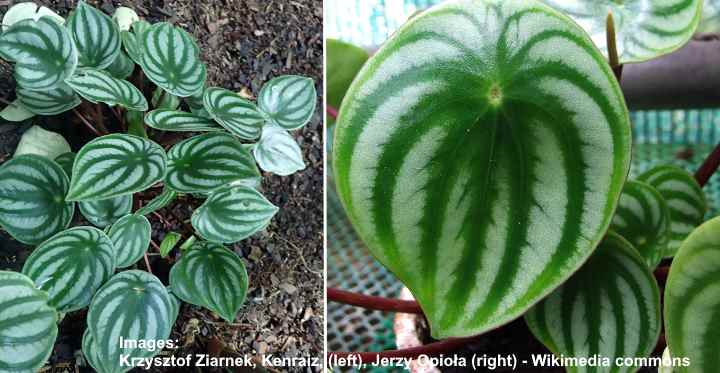
Watermelon peperomia (Peperomia argyreia, previously known as Peperomia sandersii) is a charming houseplant with striped leaves resembling a watermelon’s rind. Its succulent-like waxy leaves are oval with green and silver markings growing at the end of maroon-reddish stems. Watermelon peperomia plants can produce insignificant flower spikes at the end of long stems. The bushy houseplants grow up to 8” (20 cm) tall and are easy to grow at home.
This article is a complete care guide to growing watermelon peperomia plants indoors. You’ll find helpful advice on growing these decorative peperomia houseplants to add greenery to modern living spaces.
What is Watermelon Peperomia (Peperomia argyreia)
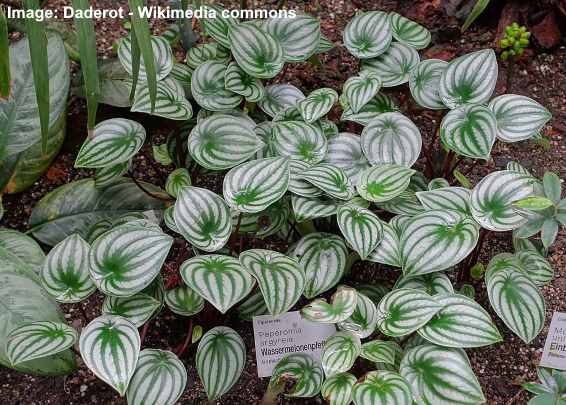
The ornamental leaves of watermelon peperomia plant have beautiful silver stripes
Watermelon peperomia is an evergreen tropical perennial in the genus Peperomia and plant family Piperaceae. The botanical name for watermelon peperomia is Peperomia argyreia, and it was previously called Peperomia sandersii. Plants in the Peperomia genus are related to pepper plants.
The botanical name of watermelon peperomia contains the word ‘argyreia’ which literally means “silvery”— referring to the stripy markings on its oval green leaves. Peperomia watermelon has ‘watermelon’ in its common name because its fleshy leaves resemble the rind of a watermelon.
Because of its leaf shape, peperomia watermelon also has the common name watermelon begonia.
Peperomia plants are heat-loving plants and are collectively known as radiator plants. The term radiator plants come from the fact that the small, compact houseplants love warm air and plenty of indirect sunlight. However, native to tropical and sub-tropical climates, peperomias—including watermelon peperomia—thrive in humid conditions.
How to Care for Watermelon Peperomia (Peperomia argyreia) — Overview
Grow watermelon peperomia plants in bright light, protected from direct sunlight. Plant watermelon peperomias in loamy, well-draining potting soil, water whenever the soil is partly dry, and mist the leaves occasionally to boost humidity. Peperomia argyreia thrives in temperatures between 65°F and 80°F (18°C – 26°C). Encourage growth by fertilizing monthly during the growing season.
Watermelon Peperomia Plant Leaves
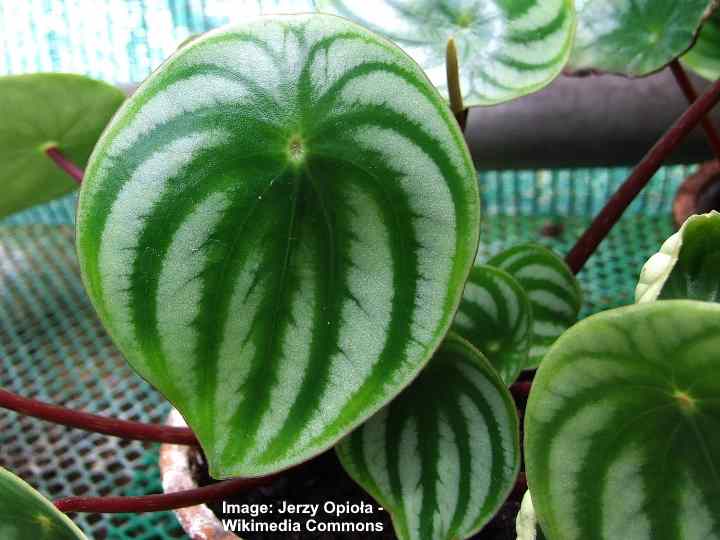
A close up picture of watermelon peperomia striped leaves
Watermelon peperomias have intriguing leaves that look like mini watermelons. The oval green pointed leaves have silvery or cream-colored curved stripes. Watermelon peperomia leaves grow on reddish-maroon stems. The rounded leaves have a waxy feel, similar to some types of succulents.
Watermelon Peperomia Flowers

Watermelon peperomia flowers look like green spikes
Watermelon peperomia plants produce green flower spikes on slim stalks. The tiny flowers are insignificant and hardly recognizable on the bushy plant. Flower stems grow to between 2” and 4” (5 – 10 cm) long. However, it’s rare for watermelon peperomias to flower indoors.
Houseplant owners grow watermelon peperomias for their pretty foliage, not the flowers.
How to Care for Watermelon Peperomia
Let’s look at the best way to grow watermelon peperomia (Peperomia argyreia) plants at home. If you follow these growing tips, your peperomia will grow for many years. You will also be able to propagate more watermelon peperomias as gifts for friends.
Watermelon Peperomia Light Requirements
Watermelon peperomia plants thrive in bright, indirect light. Plenty of light helps the variegated leaves to keep their watermelon-like appearance. Growing in a well-lit room encourages healthy growth and vibrant foliage. However, it’s vital to keep radiator plants away from direct sunlight. The sun’s hot rays can cause peperomia leaves to turn yellow and lose their color.
The best indoor location for watermelon peperomias is in an east- or west-facing room. This location ensures plenty of light without the intense midday sun. In a south-facing room, keep the peperomia plants away from the windowsill or behind a sheer curtain.
Watermelon peperomias are plants adaptable to low-light conditions. So, this peperomia species can also grow in partial or complete shade. The compact plants are ideal for growing in bathrooms, offices, or other locations where natural light is minimal.
Be aware that watermelon peperomia growth can become leggy if there’s not enough light. A lack of natural or artificial light causes its stems to stretch, and the plant can lose its compact growth. You may find that the red stems become long and straggly, and the leaves lose their watermelon patterns.
To encourage compact plant growth, trim off the leggy stems and move the watermelon peperomia to a brighter location.
Best Soil for Growing Watermelon Peperomia Plants
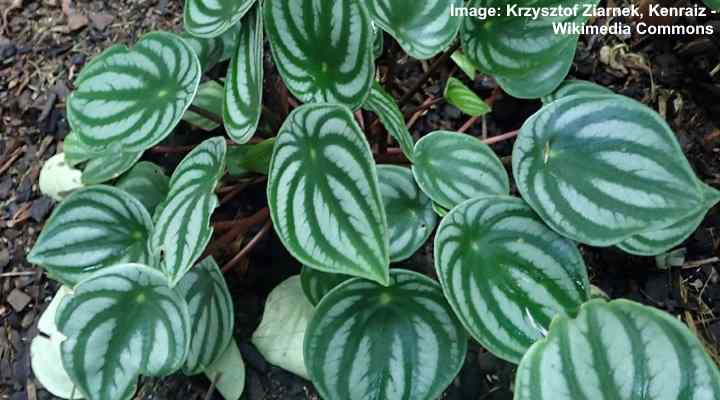
To care properly for you watermelon peperomia houseplant, make sure to grow it in well-draining soil
Watermelon peperomias must grow in a fertile potting mix that drains well. Create an ideal houseplant potting soil by mixing two parts peat moss, one part perlite, and one part coarse horticultural sand. Alternatively, good quality commercial potting mix could also work well for growing potted radiator plants.
The best potting mix for watermelon peperomia needs the right balance of organic matter—for example, sphagnum peat moss—and inorganic matter such as gravel, perlite, or poultry grit. Peat moss is light and airy and holds just enough moisture without becoming compacted. Soil amendments such as perlite are ideal for loosening potting soil to allow for excellent drainage.
The best tip for growing watermelon peperomia plants is never to allow the roots to sit in waterlogged soil. Damp, soggy soil causes root rot and, eventually, plant death.
Ideally, you need your peperomia soil to dry out reasonably fast between waterings. After a thorough soaking, an ideal soil mix should become partly dry within a few days. This is one way to check that your potting mix is suitable for watermelon peperomia.
How to Water Watermelon Peperomia Houseplants
Water watermelon peperomias as often as the top layer of soil dries out. Usually, you may need to water radiator plants about once a week in summer and hot weather. In winter, the peperomias need watering less often, maybe every three weeks or so. However, soil dryness should always be your guide to know when to water a peperomia houseplant.
To know if your watermelon peperomia needs water or not, check that the top 2” to 3” (5 – 7.5 cm) is completely dry. If there’s any moisture, hold off watering and check again in a few days. It’s always better to water peperomias less often rather than too much.
Remember that peperomias are drought-resistant plants as their fleshy, succulent-like leaves store moisture.
To water a watermelon peperomia, thoroughly drench the soil and let the excess water drain out. Then wait until half of the potting mix is dry again before the next watering. This houseplant watering technique makes sure that roots receive the necessary hydration. Letting the soil dry between watering helps to prevent overwatering.
Here are some tips about factors affecting how often you need to water Peperomia argyreia:
- Season—Most houseplants, including watermelon peperomia, have little growth during winter. This means that the compact houseplants only need minimal watering from November until February.
- Climate—Warm weather means that moisture evaporates faster from the soil. So, you’ll need to water peperomias more often in hot weather than in cold winter months.
- Type of pot—Terracotta pots are porous and allow moisture to evaporate faster than clay pots. So, remember this vital fact when watering radiator plants.
- Potting mix—Soil with high organic matter content retains moisture for longer, requiring less frequent watering.
Watermelon Peperomia Temperature Needs
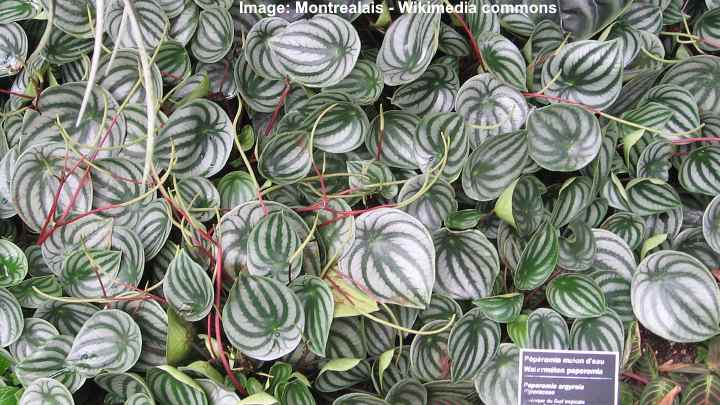
Watermelon peperomia grows well in warm temperatures
Average room temperatures are perfect for growing watermelon peperomia plants. Easy-care watermelon peperomia temperature range is 65°F to 80°F (18°C – 26°C). The minimum temperature for these tropical houseplants is 50°F (10°C). Watermelon peperomias are native to tropical and sub-tropical climates and need constant warm temperatures.
The best growing tip for watermelon peperomias is to avoid sudden temperature fluctuations. Even though they are called radiator plants, you shouldn’t place them next to hot radiators in winter. In summer, protect the tropical houseplants from cold drafts, such as open windows or airflow from the air-conditioning.
Ideal Humidity for Watermelon Peperomia
Average indoor humidity is perfect for watermelon peperomias. Although watermelon peperomias are native to warm, humid climates, they adapt well to drier household air. Low to medium humidity levels are adequate. But to ensure healthy growth, mist the leaves occasionally to mimic their native environment.
Misting watermelon peperomia leaves is usually necessary during summer. Warm outdoor temperatures can create dry air indoors. However, if you’ve got central heating, some leaf misting may also be useful in winter.
To mist the watermelon peperomia plant leaves, fill a spray bottle with filtered or distilled water. Set the spray to the finest setting and create a fine mist over the plant’s foliage. Mist the leaves once a week if necessary, or more often in summer if the leaves seem to be drooping.
Other ways to help humidify watermelon peperomias include the following:
- Place the watermelon peperomia pot on a pebble and water tray, so the tray’s moisture humidifies the leaves.
- Grow watermelon peperomia plants together with other houseplants for extra air moisture.
How to Fertilize Watermelon Peperomia
Watermelon peperomias are slow growers and have modest fertilizing needs. To encourage healthy growth, apply a diluted organic houseplant fertilizer monthly during the growing season. Dilute to about one-half of the manufacturer’s recommendations. However, you may find that your cheerful watermelon peperomia thrives without additional ‘feeding.’
It’s better to use organic houseplant fertilizers rather than synthetic ones. Organic fertilizers such as tea compost, sea kelp, and plant extracts provide all the nutrients your potted peperomia needs.
Here are a few fertilizing tips when caring for watermelon peperomias:
- Never apply fertilizer in late fall and winter because plant growth is dormant.
- If using synthetic fertilizers, flush the soil every three months to prevent a buildup of mineral salts.
Repotting Watermelon Peperomia Houseplants
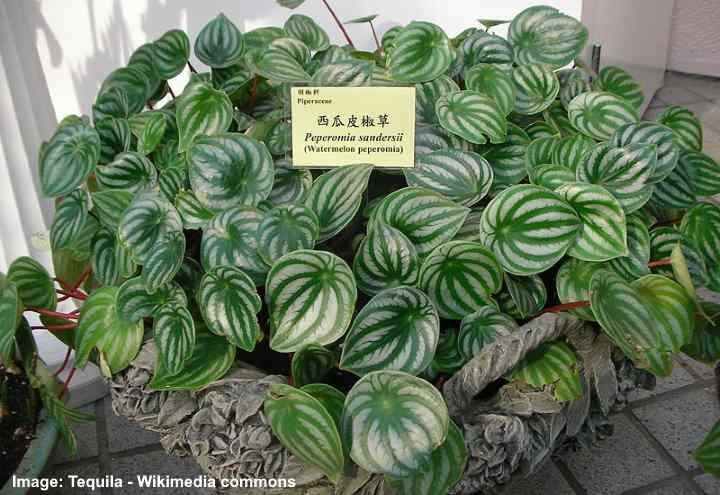
You don’t need to repot watermelon peperomia often as they are slow growers and thrive when rootbound
Easy-to-care-for watermelon peperomias don’t require repotting often. The small, compact houseplants thrive when rootbound. So, at most, you will only have to repot them every two or three years. Repotting is also useful to refresh the potting mix and replenish soil nutrients to encourage healthy growth.
You know when it’s time to repot a watermelon peperomia when you see roots poking out the pot’s drainage holes.
To repot your watermelon peperomia, choose a pot one size up from its current container. Remove the plant and root ball from the pot and shake off loose soil. Check for any signs of root disease—mushy, decaying roots—and trim as necessary. Place the peperomia in a new pot and fill with an appropriate potting mix. Make sure that the plant is growing at the same height in the pot as previously.
Watermelon Peperomia Propagation
Propagating a watermelon peperomia plant is best done by rooting stem cuttings. Snip off a healthy leaf, leaving about 1-2 cm of the stem. Place the peperomia stem cutting in a shallow jar of water and put it in a sunny location. After a few weeks, roots should appear. Transfer the cutting to a small pot that contains moist potting soil. Wait until the soil dries before watering it thoroughly.
The other watermelon peperomia propagation method is by leaf cutting. Cut off a healthy leaf from the plant. Then, cut the leaf in half horizontally and place it on a paper towel for a few days to allow the ‘wound’ to callus. Then plant the leaf cutting directly in moist soil. Cover with plastic to lock in moisture and keep the soil moist—not damp—until roots appear
How to Prune Watermelon Peperomia
Lightly pruning watermelon peperomias every spring is useful to remove any leggy stems. Trimming dead leaves and straggly growth helps to improve the plant’s appearance. Getting rid of unnecessary foliage also encourages bushy growth by directing the plant’s energy into new growth.
Are Watermelon Peperomia Plants Poisonous?
Watermelon peperomia plants are not poisonous for cats, dogs, or other household pets. According to the ASPCA, Peperomia sandersii (Peperomia argyreia) is on the list of non-toxic houseplants.
Pests Affecting Watermelon Peperomia Growth
Healthy watermelon peperomia plants have few—if any—problems with common houseplant pests. If you care for a peperomia well by not overwatering it, the plant will thrive for many years. Also, bright light helps to encourage robust growth to make the plant resistant to bugs.
The most common pest to affect weakened watermelon peperomias is mealybugs. You can spot mealybugs by the cotton wool-like furry substance they leave behind on leaves. If you want to get rid of mealybugs and other houseplant pests, use a neem oil organic pesticide.
Make a neem oil bug spray by adding 2 tsp. organic neem oil and 1 tsp. liquid dish soap to a spray bottle containing 1-quart (1 l) of lukewarm water. Mix thoroughly and then spray liberally on the plant’s foliage to eradicate bugs. Use the neem oil solution once a week to get rid of plant bugs.
You can also use the neem oil pest control spray if you notice spider mites or whitefly infestations on your houseplants.
Diseases Affecting Watermelon Peperomia Growth
If you care for your watermelon peperomia well, you will have no plant disease or infection issues. The only problem watermelon peperomia plants have is if you overwater them. Soggy soil causes roots to rot and fungal diseases to flourish.
If you suspect your peperomia has decaying roots, you should repot the plant to help bring it back to life. Dispose of the old potting soil, trim off brown decaying roots, and replant in a fresh potting mix.
FAQs About Watermelon Peperomia Plant Care
Watermelon peperomia plants are perfect for beginners because they are easy to care for. However, a few issues can affect the plant’s growth.
Why are my watermelon peperomia leaves drooping?
Watering issues are the most common reason for drooping watermelon peperomia leaves. Soil that’s too damp or too dry can affect the plant’s growth. The result is that the stems lose strength and start to wilt.
To revive your watermelon peperomia, try to determine the underlying cause. If the soil is damp and mushy, either stop watering it until the soil dries or replace the potting mix.
If the soil is completely dry—for example, it’s dry around the roots—give the soil a thorough soaking and let the excess water drain out. In the future, check the potting soil every week for dryness and water as necessary.
My watermelon peperomia plant leaves are turning yellow, what should I do?
Yellow leaves are a common sign of overwatering a watermelon peperomia. Always follow the right houseplant watering methods by allowing potting soil to dry partially between soil drenching.
Yellow watermelon peperomia leaves could also signify root rot—also caused by overwatering the plant.
Discover other beautiful types of peperomia plants.
Related articles:
